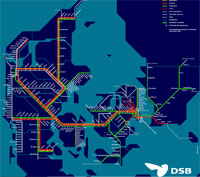- Before Software can be Designed its Requirements ought be known.
- Before Requirements can be established the Domain ought be understood.
- Hence I work in the triptych area of Domain Engineering, Requirements Engineering and Software Design.
- Together I call this Software Engineering.
Thus programming, in my view, spans from:
- domain engineering via
- requirements engineering to
- software design.
By a method I understand:
- a set of principles
- for selecting and applying
- techniques and
- tools
- in order efficiently to construct
- an efficient artifact, here software.
So my endeavour is to indentify, analyse and formalise (whereever the latter is reasonable) such principles and techniques. At the moment I am primarily interested in domain engineering, requirements engineering, software architecture and program organisation design. I have identified a number of core domain engineering issues: intrinsics, support technology, management & organisation, rules & regulations, and human behaviour facets as these also relate to domain stake-holder perspectives. Similarly I have identified a number of core requirements engineering issues. In particular domain requirements - with its subsidiary techniques of projection, instantiation, extension and initialisation. In domain engineering one describes the domain without any reference to Requirements. The new thing here is to establish theories of domains -- as we have theories of such ``domains'' as physics, biology, etc.
- On one hand there is the study of the concept of an `infrastructure' and its `components'.
- On the other hand there is the study of particular such infrastructure components.
As targets of the application of the above-mentioned programming methodological ideas I apply these to such infrastructure components as:
-
Transport:
Railways, Logistics, Air Traffic,
Airports, etc.

I am currently working on a domain model for multi-modal transportation nets. This documents is, as of January 12, rather incomplete.
Such models ought be of interest to companies like:
- Alstom,
- Alcatel--Dassault Transportation (Thales),
- Atkins (Denmark),
- Banestyrelsen: Danish National Railway Authority,
- Bombardier Transportation,
- Copenhagen Airports,
- DSB: Danish ``State'' Railways,
- GE Transportation Systems, Global Signalling,
- Pacific Railways,
- Scandinavian Airlines (SAS),
- Siemens Transportation Systems,
- Transvision (Denmark),
I can provide references to many reports and publications concerning this area.
The below entries will soon be equipped with appropriate URLs.
-
Financial Service Industry:
Banking, Insurance, Securities
Trading, etc.
Ought be of interest to companies like:
- Danica (insurance),
- Danish National Stock Exchange,
- Danske Bank + BG Bank,
- Hitachi,
- IBM,
- Jyske Bank,
- Nordea,
- TopDanmark (insurance),
- Unisys, etc.
I can provide references to reports concerning this area.
-
Healthcare Sector:
Flow of people, materials, information and
control in the healthcare secotr - patient medical jounrals being a
first study.
Ought be of interest to companies like:
- H:S + KAS (Copenhagen Capital City and Province Hospitals),
- IBM,
- Sundhedsstyrelsen (Danish National Board of Health),
- Systematic,
- Tieto Enator,
- WM Data,
- etc.
We can provide references to reports concerning this area.
-
Electronic Business / Electronic Government:
The published paper ... The Market Domain .... ought be of interest to companies interested in E-Commerce.
-
Project and Production Planning and Execution:
I am currently working on a domain model of manufacturing. This documents is, as of January 12, VERY incomplete.
Ought be of interest to companies like:
I can provide references to reports concerning this area.
An aim is -- eventually -- to identify infrastructure component theories, and thereby to better answer the question: ``What is an Infrastructure ?''